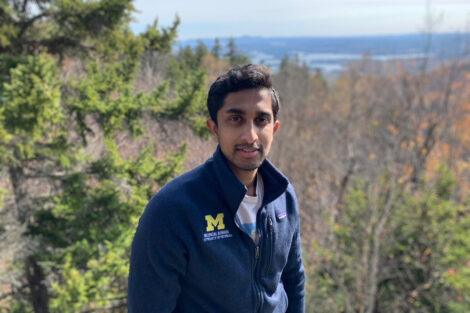Ajay Kolli, MPH ’21, hopes to boost population health by improving eyesight
March 8, 2021 – When Ajay Kolli first started thinking about the association between diet and vision, he figured he’d find plenty of previous studies about the topic.
But Kolli, a University of Michigan medical student on his way to becoming a ophthalmologist, was surprised to find that there were very few. So when he arrived at Harvard T.H. Chan School of Public Health last fall—taking a year off from medical school to pursue an MPH in quantitative methods—he reached out to Erica Kenney, assistant professor of public health nutrition. They brainstormed and came up with a plan to use data from the National Health and Nutrition Examination Survey (NHANES) to look at the association between both diet and vision impairment, and between food insecurity and vision impairment. Preliminary results from their research suggest links in both cases.
Seeing disparities
Kolli became interested in learning more about the factors that contribute to vision problems as an undergraduate at Michigan. During volunteer stints and medical school rotations at local health clinics and with homeless populations in Ann Arbor and nearby Ypsilanti, he kept noticing disparities in people’s vision and access to eye care.
“I saw a lot of people who couldn’t see very well due to conditions for which treatments exist,” he said. “The issue was that they couldn’t access the medications or the surgeries they needed. That’s what got me thinking about public health.”
Beyond the quality of life improvements that vision interventions such as cataract surgery and glaucoma medication can provide, Kolli is also interested in their cost-effectiveness. He tweeted recently, “One of the reasons I’m drawn to the intersection of ophthalmology and public health is that vision-improving interventions are some of the most cost-effective/saving of all medical interventions. Eliminating reversible blindness will have huge health benefits and pay for itself.”
As an example, Kolli cited a paper he worked on as an undergraduate that showed that the costs of eliminating cataract-related vision impairment in India ($2.6 billion) were minor in comparison to the estimated societal benefits ($13.5 billion). The paper noted, for example, that the cost of cataract surgery at the Aravind Eye Hospital-Madurai was relatively inexpensive—roughly $195—and yet it improved people’s quality of life and led to economic benefits for communities. People who had cataract surgery were more likely to be engaged in income-generating activities and to have higher household income than those who didn’t have the surgery, the study found.
Better diet, better vision
In his research with Kenney, Kolli found that, compared with people who ate the healthiest diets, those who ate the poorest diets had a 29% greater odds of self-reported vision impairment. The link was even stronger between food insecurity and vision: Compared to people with full food security, those with very low food security had 170% greater odds of objectively measured vision impairment, and 85% greater odds of self-reported vision impairment. “We think this strong association may be because food insecurity not only contributes to poor diet, but also causes chronic stress, which may have additional effects on the eyes,” said Kolli.
He added, “The association between food and vision is likely complex and bidirectional. Poor vision may make it harder for people to do things like access transportation, obtain groceries, and cook, which can in turn contribute to poor diet and food insecurity. Future studies with longitudinal data would be needed to determine which direction—poor diet leading to poor vision, or the other way around—if any, may play a larger role.”
Kenney has been very impressed by Kolli’s work. “It has really been a delight to watch him take all the tools he’s learned for analyzing epidemiological data and apply them to his project. He’s developed some novel analyses investigating the linkages between diet quality, socioeconomic indicators, and vision health that I think will be a great contribution to the field.”
She added, “Ajay is one of those students who helps make being an educator at Harvard Chan School one of the best jobs in the world.”
Looking ahead
Kolli sees a need for more cost-effectiveness research about another type of vision intervention: low-vision aids, which are devices such as strong magnifying reading glasses or small telescopes. Such devices may not typically be covered by insurance, but recent research has shown an association between low vision and decreased use of preventive procedures such as colonoscopies or mammograms. Researchers have speculated that difficulties with appointment management or transportation could be barriers keeping people with low vision from routine screenings. “There could be evidence—if it was studied—that giving people low-vision aids could actually be cost-saving in the long run by increasing people’s access to health care, which may lead to better detection, treatment, and prevention of any number of conditions such as falls, other injuries, cancers, cardiovascular disease, or stroke,” he said. “Providing these aids may also have societal cost benefits by offering solutions to people with work-preventing visual disabilities.”
Two years ago, spurred by his deep interest in ophthalmology research, Kolli and two fellow medical students co-founded a weekly online newsletter called The Lens that offers reader-friendly summaries of recent high-impact ophthalmology studies with links to the full articles. The newsletter started out with a readership of 20 students at the University of Michigan; today it has 1,000 readers from all over and a team of 13 medical students from the U.S. and Canada producing the summaries. “It’s something I’ve been really passionate about,” said Kolli. “There are thousands of new articles every year, and it’s hard to find to time to read them with a busy clinical schedule. We wanted to create a way for people to re-engage with the literature.”
Kolli aims to pursue an academic career so that he can keep his research questions front and center. “What I’m most interested in is how poor vision impacts people’s day-to-day lives,” he said. “And how health disparities may influence and magnify this relationship.”
photo courtesy Ajay Kolli
